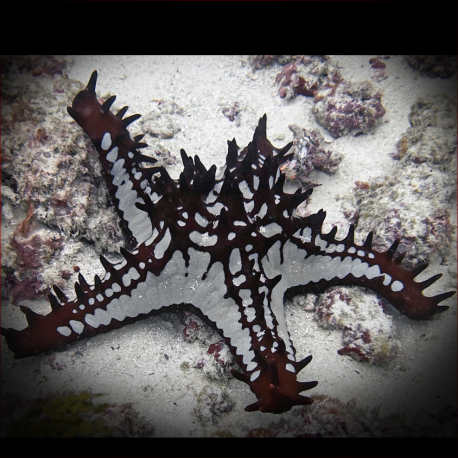More info
Datasheet
| Minimum Tank Size | 1000 litres / 264.17 US gallons |
| Maximum Size | 30.0cm / 11.81inches |
| Reef Compatible | Not reef safe |
| Temperament | Peaceful |
| Temperature | 22.2°C / 71.96°F - 25.6°C / 78.08°F |
| Specific Gravity | 1.020-1.025 |
| Carbonate Hardness | 8-12 |
| pH | 8.1-8.4 |
General Description: The Red Knob Sea Star, scientifically known as Protoreaster linckii, is a member of the Asteroidea family. This sea star species, found in the East Indian Ocean, West Indian Ocean, and Indonesia, can grow up to 30.0cm in size. With its striking red knobs on its dorsal side, this sea star adds a pop of color to marine aquariums.
Aquarium Suitability: The Red Knob Sea Star is classified as suitable with care for aquariums. While it can be a peaceful addition to a marine tank, it is important to note that this species may consume various invertebrates such as crabs, clams, soft corals, sea stars, and sea urchins. Additionally, it has been observed to potentially prey on sleeping or weakened fish, so caution must be exercised.
Demands, Care and Hardiness: Categorized as Average in hardiness, the Red Knob Sea Star requires a tank of at least 1000 liters and specific water conditions. It thrives in a pH range of 8.1-8.4, with a carbonate hardness (KH) of 8-12 and a specific gravity (SG) of 1.020-1.025. Maintaining stable water temperature between 22.2-25.6℃ and ensuring low nitrate and phosphate levels are crucial for its well-being.
Reef Suitability: Not reef safe, the Red Knob Sea Star is not suitable for reef aquariums due to its tendency to feed on various invertebrates and soft corals. Its diet preferences make it incompatible with a reef ecosystem, as it may disturb the balance and health of the coral and other invertebrate inhabitants.
Aquarium Setup: When setting up an aquarium for the Red Knob Sea Star, provide ample hiding spots and ensure a well-established tank with a matured biological filtration system. Maintaining pristine water quality, offering diverse sources of food like large polyp stone coral, crustaceans, macroalgae, and soft coral, and acclimating the sea star carefully to avoid stress are essential for its longevity.
Behaviour: This sea star is known to be peaceful in temperament but can exhibit predatory behavior towards smaller invertebrates and potentially sleeping fish. Observing its interactions with other tank mates and ensuring that it is well-fed can help mitigate any aggressive tendencies.
Feeding and Diet: The Red Knob Sea Star primarily feeds on large polyp stone coral, larger crustaceans like shrimp and crabs, macroalgae such as seaweed or nori, microalgae like spirulina, and other invertebrates. Regular feeding and monitoring for signs of starvation are vital to its health in a captive environment.
Habitat and Distribution: In its natural habitat across the East Indian Ocean, West Indian Ocean, and Indonesia, the Red Knob Sea Star can be found in coastal waters with rocky or sandy substrates. It plays a role in the ecosystem by preying on invertebrates and contributing to the overall biodiversity of the marine environment.

